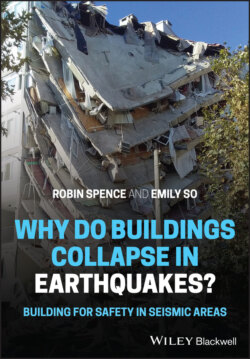Читать книгу Why do buildings collapse in earthquakes? Building for safety in seismic areas - Robin Spence - Страница 19
2.2.3 The 26.12.2004 Indian Ocean Earthquake and Tsunami: Mw = 9.1, 225 841 Deaths
ОглавлениеAt 7.59 a.m. on 26 December 2004, one of the largest earthquakes of the last 100 years anywhere in the world occurred in the Sunda trench in the Indian Ocean. At Mw9.1, the earthquake was one of the largest ever recorded, and had the longest duration of faulting ever recorded (between 8 and 10 minutes), with a fault rupture extending for 1300 km. The earthquake caused ground shaking over a wide region, but because of the extraordinary length of the fault rupture and the movement on it, the earthquake also triggered a massive and destructive tsunami, which devastated the coasts bordering the Indian Ocean, causing huge loss of life. The initial ground shaking was destructive throughout Aceh Province of Indonesia, particularly in the main city of Banda Aceh, and also in the Andaman and Nicobar Islands. But the tsunami carried the earthquake's energy over a much wider region, causing destruction throughout coastal northern Sumatra, and in all the countries bordering the Indian Ocean. Casualties caused by the tsunami were reported in 12 different countries, but most of the tsunami‐related deaths occurred in Indonesia (165 000), Sri Lanka (36 000), India (16 000) and Thailand (8000). In Aceh Province of Indonesia, it destroyed virtually every village, town, road and bridge along a 170 km stretch of coast that was not more than 10 m above sea level. The death toll was over 16% of the entire population of the northernmost six districts of the province. Inundation depths reached up to 20 m in parts of Sumatra, 5–8 m in Thailand, and 2–5 m in South‐eastern India and Eastern and Southern Sri Lanka (EEFIT 2006).
The tsunami was devastating to small buildings wherever the inundation depth was 2 m or more, and huge numbers of buildings of timber or traditional masonry were destroyed in Indonesia, Thailand and Sri Lanka (EEFIT 2006) (Figures 2.7 and 2.8). RC buildings of several storeys often survived but with serious damage, although there were cases of collapse through scour under the foundations. The huge loss of life was primarily due to the direct effects of the tsunami itself. Victims were either drowned directly or as a result of injuries caused by impact with debris from buildings or other objects: ‘falling structures and waters full of swirling debris inflicted crush injuries, fractures and a variety of open and closed wounds’ (WHO 2006). Tens of thousands were swept out to sea, and were ultimately recorded as missing, and were presumed drowned.
Figure 2.7 Damage caused by the 26 December 2004 tsunami at Unawatuna, Sri Lanka where the inundation depth was about 5 m. Damage to a masonry building.
Source: EEFIT. Reproduced with permission.
Figure 2.8 Damage caused by the 26 December 2004 tsunami at Unawatuna, Sri Lanka where the inundation depth was about 5 m. Damage to a reinforced concrete frame building.
Source: EEFIT. Reproduced with permission.
In Sri Lanka and Thailand, many of the victims were foreign tourists. It has been estimated that the death rate in the worst hit areas in Sri Lanka and Thailand was over 10% of the resident population within 1 km of the coast. A study of the life loss in Indonesia, India and Sri Lanka found that in certain locations the disaster claimed four times as many lives among women as men (EEFIT 2006).
It is clear from all accounts that an effective warning system, coupled with a better understanding of the phenomenon of tsunamis among both residents and visitors could have saved many lives, since the tsunami struck the Thai and Sri Lankan coasts more than 90 minutes after the earthquake.
A study carried out by our own team of the experiences of eyewitnesses (Spence et al. 2009) showed very strong correlation between survival and distance from the shore: all of those within 15 m of the shore reported serious injury or fatalities in their group, but less than half of those more than 30 m away did. Most survivors who were in the affected zone attributed their survival either to prompt action in moving to safer ground, or to being in a building which survived.
